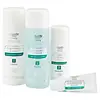What's inside
What's inside
 Key Ingredients
Key Ingredients

 Benefits
Benefits

 Concerns
Concerns

 Ingredients Side-by-side
Ingredients Side-by-side

Water
Skin ConditioningPropanediol
SolventDimethicone
EmollientCetearyl Ethylhexanoate
EmollientNiacinamide
SmoothingAmmonium Polyacryloyldimethyl Taurate
Emulsion StabilisingDipotassium Glycyrrhizate
HumectantHydrogenated Lecithin
EmulsifyingPotassium Phosphate
BufferingCeramide NP
Skin ConditioningCeramide AP
Skin ConditioningCeramide EOP
Skin ConditioningCarbomer
Emulsion StabilisingCetearyl Alcohol
EmollientBehentrimonium Methosulfate
Dimethiconol
EmollientLecithin
EmollientSodium Citrate
BufferingRetinol
Skin ConditioningSodium Hyaluronate
HumectantSodium Lauroyl Lactylate
EmulsifyingCholesterol
EmollientPhenoxyethanol
PreservativeAlcohol
AntimicrobialIsopropyl Myristate
EmollientCaprylyl Glycol
EmollientCitric Acid
BufferingTrisodium Ethylenediamine Disuccinate
Pentylene Glycol
Skin ConditioningPhytosphingosine
Skin ConditioningXanthan Gum
EmulsifyingPolysorbate 20
EmulsifyingEthylhexylglycerin
Skin ConditioningWater, Propanediol, Dimethicone, Cetearyl Ethylhexanoate, Niacinamide, Ammonium Polyacryloyldimethyl Taurate, Dipotassium Glycyrrhizate, Hydrogenated Lecithin, Potassium Phosphate, Ceramide NP, Ceramide AP, Ceramide EOP, Carbomer, Cetearyl Alcohol, Behentrimonium Methosulfate, Dimethiconol, Lecithin, Sodium Citrate, Retinol, Sodium Hyaluronate, Sodium Lauroyl Lactylate, Cholesterol, Phenoxyethanol, Alcohol, Isopropyl Myristate, Caprylyl Glycol, Citric Acid, Trisodium Ethylenediamine Disuccinate, Pentylene Glycol, Phytosphingosine, Xanthan Gum, Polysorbate 20, Ethylhexylglycerin
Allantoin
Skin ConditioningCarbomer
Emulsion StabilisingCeteareth-20
CleansingCetearyl Alcohol
EmollientCyclopentasiloxane
EmollientCyclotetrasiloxane
EmollientDiazolidinyl Urea
PreservativeDimethicone
EmollientEthoxydiglycol
HumectantParfum
MaskingGlyceryl Stearate
EmollientMethylparaben
PreservativePanthenol
Skin ConditioningPEG-100 Stearate
Propylene Glycol
HumectantPropylparaben
PreservativeWater
Skin ConditioningTriethanolamine
BufferingXanthan Gum
EmulsifyingButylene Glycol
HumectantCymbopogon Schoenanthus Extract
Skin ConditioningEthylparaben
PreservativeGeranium Maculatum Extract
TonicGlycereth-26
HumectantHydrated Silica
AbrasiveKaolin
AbrasiveLinoleic Acid
CleansingLinolenic Acid
CleansingMagnesium Aluminum Silicate
AbsorbentMelaleuca Alternifolia Leaf Oil
AntioxidantSodium Lauroyl Sarcosinate
CleansingTitanium Dioxide
Cosmetic ColorantTocopherol
AntioxidantTocopheryl Acetate
AntioxidantZinc Oxide
Cosmetic ColorantAllantoin, Carbomer, Ceteareth-20, Cetearyl Alcohol, Cyclopentasiloxane, Cyclotetrasiloxane, Diazolidinyl Urea, Dimethicone, Ethoxydiglycol, Parfum, Glyceryl Stearate, Methylparaben, Panthenol, PEG-100 Stearate, Propylene Glycol, Propylparaben, Water, Triethanolamine, Xanthan Gum, Butylene Glycol, Cymbopogon Schoenanthus Extract, Ethylparaben, Geranium Maculatum Extract, Glycereth-26, Hydrated Silica, Kaolin, Linoleic Acid, Linolenic Acid, Magnesium Aluminum Silicate, Melaleuca Alternifolia Leaf Oil, Sodium Lauroyl Sarcosinate, Titanium Dioxide, Tocopherol, Tocopheryl Acetate, Zinc Oxide
 Reviews
Reviews

Ingredients Explained
These ingredients are found in both products.
Ingredients higher up in an ingredient list are typically present in a larger amount.
Carbomer is a polymer of acrylic acid. Its main role is to create a gel consistency.
A high amount of carbomer can cause pilling or balling up of products. Don't worry, most products contain 1% or less of carbomer.
Cetearyl alcohol is a mixture of two fatty alcohols: cetyl alcohol and stearyl alcohol. It is mainly used as an emulsifier. Emulsifiers help prevent the separation of oils and products. Due to its composition, it can also be used to thicken a product or help create foam.
Cetearyl alcohol is an emollient. Emollients help soothe and hydrate the skin by trapping moisture.
Studies show Cetearyl alcohol is non-toxic and non-irritating. The FDA allows products labeled "alcohol-free" to have fatty alcohols.
This ingredient is usually derived from plant oils such as palm, vegetable, or coconut oils. There is debate on whether this ingredient will cause acne.
Due to the fatty acid base, this ingredient may not be Malassezia folliculitis safe.
Learn more about Cetearyl AlcoholDimethicone is a type of synthetic silicone created from natural materials such as quartz.
What it does:
Dimethicone comes in different viscosities:
Depending on the viscosity, dimethicone has different properties.
Ingredients lists don't always show which type is used, so we recommend reaching out to the brand if you have questions about the viscosity.
This ingredient is unlikely to cause irritation because it does not get absorbed into skin. However, people with silicone allergies should be careful about using this ingredient.
Note: Dimethicone may contribute to pilling. This is because it is not oil or water soluble, so pilling may occur when layered with products. When mixed with heavy oils in a formula, the outcome is also quite greasy.
Learn more about DimethiconeWater. It's the most common cosmetic ingredient of all. You'll usually see it at the top of ingredient lists, meaning that it makes up the largest part of the product.
So why is it so popular? Water most often acts as a solvent - this means that it helps dissolve other ingredients into the formulation.
You'll also recognize water as that liquid we all need to stay alive. If you see this, drink a glass of water. Stay hydrated!
Learn more about WaterXanthan gum is used as a stabilizer and thickener within cosmetic products. It helps give products a sticky, thick feeling - preventing them from being too runny.
On the technical side of things, xanthan gum is a polysaccharide - a combination consisting of multiple sugar molecules bonded together.
Xanthan gum is a pretty common and great ingredient. It is a natural, non-toxic, non-irritating ingredient that is also commonly used in food products.
Learn more about Xanthan Gum